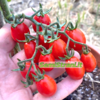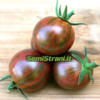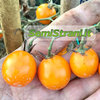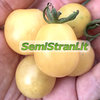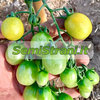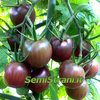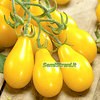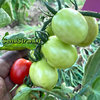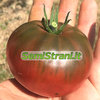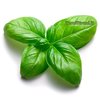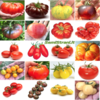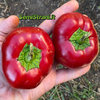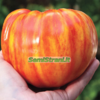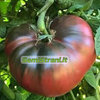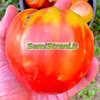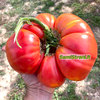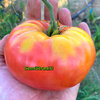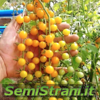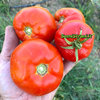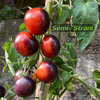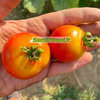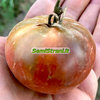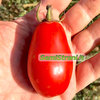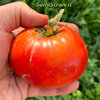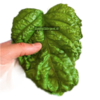The Red Prince Borghese Tomato from Vesuvius is perhaps the most legendary tomato in the world and could only come from an equally mythical place such as the slopes of the Vesuvius volcano in Naples. But let's immediately clarify what this famous tomato is, it should be specified that the denomination "Pomodorino del Piennolo del Vesuvio Dop" can LEGALLY refer ONLY AND EXCLUSIVELY to the product certified Dop by Agroqualità and cultivated in the Volcanic complex of Somma-Vesuvius in Naples, including the its slopes degrading almost to sea level, in particular, the production and conditioning area envisaged by the specification of the "Pomodorino del Piennolo del Vesuvio DOP" includes: the entire territory of the following municipalities in the province of Naples: Boscoreale, Boscotrecase, Cercola , Ercolano, Massa Di Somma, Ottaviano, Pollena Trocchia, Portici, Sant'Anastasia, San Giorgio a Cremano, San Giuseppe Vesuviano, San Sebastiano al Vesuvio, Somma Vesuviana, Terzigno, Torre Annunziata, Torre del Greco, Trecase and part of the territory of the municipality of Nola bounded on the perimeter by the provincial road Piazzola di Nola – Rione Trieste (for the stretch that goes under the name of " Constantinople"), from the "Lagno Rosario", from the limit of the municipality of Ottaviano and from the limit of the municipality of Somma Vesuviana.
Observe in my video the plant and the tomatoes in all their beauty: Red Prince Borghese Vesuvius Tomato, the best and most legendary tomato in the world
The Piennolo del Vesuvio Tomato is a variety of tomato grown exclusively on the volcanic slopes of Vesuvius, therefore even having the usual Seeds, if not grown in this specific legally authorized area, it cannot be defined as such, also because the salient characteristics of the flavor, as sweetness and acidity are given by the volcanic land, the proximity of the sea and by that particular climate. Already recognized as a traditional agri-food product by the Campania Region in South Italy, the "Pomodorino del Piennolo del Vesuvio" or "spungilli cherry tomatoes harvested in piennolo or ceppa" has become a Protected Variety by Italian Law (Dop) since 2009.
Therefore, in order not to get confused, the Seeds that you can buy on this page are called Red Prince Borghese Tomato from Vesuvius because, as widely described, only those grown in the areas mentioned above (around Naples in Italy) can have the name of Piennolo Tomato.
The Dop production regulations list some ecotypes of the species Lycopersicon Esculentum (botanical name of the tomato in question) to refer to. No specific variety is indicated: the reason is that each family of growers has, in practice, its own precious Seed selected over time, given that the cultivation of cherry tomatoes on Vesuvius is ancient and that the seedlings have always been part of the vegetable garden of home.
Therefore there is no identification of a single Piennolo tomato from Vesuvius, but there are very common characteristics that characterize the various ecotypes, in fact they are old cultivars and local biotypes united by more or less similar morphological and qualitative characteristics, whose selection it has been taken care of over the decades by the farmers themselves. The denominations of these ecotypes are the popular ones attributed by the local producers themselves, such as "Fiaschella", "Lampadina", "Patanara", "Prince Borghese" and "Re Umberto", traditionally cultivated for centuries in the same territory of origin. The distinctive characteristics, at a technical-commercial level, of the product admitted to protection are, in the fresh state: oval or slightly plum-shaped fruit with pointed apex and frequent ribs on the peduncle part, thick vermilion red skin, size not exceeding 25 g, flesh of high consistency and red colour, lively, intense and sweet-sour flavour; preserved in Piennolo: dark red color of the skin, red flesh of good consistency, intense and lively flavour. The "Piennoli" or "Schiocche" have a weight, at the end of conservation, which varies between 1 and 5 kilograms. For the purposes of the protection action, it was found that the peculiar aspect of typicality that unites the Vesuvius cherry tomatoes is the ancient practice of "al piennolo" conservation, i.e. a technical characteristic for binding together some bunches or "shells" of ripe cherry tomatoes, to form a large bunch which is then suspended in ventilated rooms, thus ensuring optimal conservation of the precious harvest until the end of winter. Over the months the cherry tomato, while losing its turgor, takes on a unique and delicious flavor, which especially the Neapolitans particularly appreciate for preparing delicious and inviting sauces. It is precisely the "piennolo" preservation system which, by favoring a slow maturation, also allows a long preservation, with the consequent possibility of consuming the product "natural" until the following spring.
The peculiarities of the "Pomodorino del Piennolo del Vesuvio DOP" (the Small Tomato Piennolo from Vesuvio protected by law) are the high consistency of the peel, the strength of attachment to the peduncle, the high concentration of sugars, acids and other soluble solids which make it a long-life product during which none of the its organoleptic qualities undergo alterations. These peculiarities are deeply linked to the pedoclimatic factors typical of the geographical area in which the cherry tomato is grown where the soils, of volcanic origin, are made up of pyroclastic material originating from the eruptive events of the Somma-Vesuvius volcanic complex. Therefore, we repeat, if it is not grown in that area it cannot be considered the real Piennolo tomato from Vesuvius. In this environment of choice, the quality of the tomato reaches peaks of excellence. Precisely the richness in organic acids determines the vivacity or "sourness" of taste, which is the distinctive character of the Vesuvius tomato. This, in addition to deriving from a genetic peculiarity, is indicative of a cultivation method with low environmental impact and with reduced use of irrigation water, which makes this crop particularly suitable for a protected area, such as that of the Vesuvius National Park . Due to its qualities, the "Pomodorino del Piennolo del Vesuvio DOP" is a fundamental ingredient of Neapolitan and Campania cuisine in general, and has great versatility in the kitchen. Alongside the traditional Spaghetti alle Vongole and other seafood, local chefs are committed to using it in many other dishes, including a variant of the delicious Neapolitan Pizza.
Finally, some historical notes and curiosities: little is certain about the origin of the tradition of tying this tomato, but a story that has been handed down for generations is particularly suggestive, in fact it is said that in Torre del Greco, a town nestled between Vesuvius and the Gulf of Naples, the wives of fishermen were always busy mending and weaving their companions' fishing nets. When they left for the sea, the women used to weave whatever came their way, on the one hand to keep busy, on the other not to lose their hand. Tradition has it that one day the branches of the cherry tomato seedlings fell into their hands, then leading the plant to grow with the cluster shape that still distinguishes them today. Whether this is the origin or just a beautiful invented story passed from generation to generation, what we can certainly say about the Vesuvius piennolo tomato is that its journey starts from afar, to be exact from Peru. The then Viceroy of Peru, for the coronation of King Ferdinand IV (1759), donated tomatoes to the royal court, which were then planted in one of the most fertile areas of the territory: the slopes of Vesuvius. Here the tomato not only grew and adapted, but developed the organoleptic characteristics that distinguish it and make it one of the most valuable and sought-after tomato varieties in the world.
This tomato is so loved by the people of Campania that it deserves a very special legend. According to the myth, Lucifer created Naples by stealing a piece of Paradise but, due to his touch, the lands of this idyllic place became arid, impossible to cultivate. It was for this reason that Jesus began to weep all his tears and something miraculous happened: falling from the slopes of Vesuvius, his tears made the ground fertile again, thus giving life to that concentration of history, magic, taste and tradition which is the Piennolo tomato from Vesuvius.
The cultivation of the Piennolo tomato on the slopes of Vesuvius undoubtedly has ancient and well-documented roots. To limit ourselves to the most illustrious historical testimonies, information on the product is reported by Bruni, in 1858, in his "Of vegetables and their cultivation in the city of Naples", where he speaks of cherry tomatoes, very tasty, which "remain excellent until in the spring, as long as they are tied in wreaths and suspended from the attics". Another reliable literary source is that of Palmieri, who in the Yearbook of the Royal Higher School of Agriculture in Portici (current Faculty of Agriculture), of 1885, speaks of the practice in the Vesuvius area of conserving the berries of the p'appennere variety in places shaded and ventilated. Francesco De Rosa, another professor of the School of Portici, in "Italia Orticola" of November 1902, specified that the old Vesuvius "cerasella" had gradually been replaced by the "flask" type, more suitable for conservation in piennolo. De Rosa is also the first researcher who exhaustively reports the entire cultivation technique of Vesuvian cherry tomatoes, thus implying that an entire economy was developing in the area around this product, from the production of seedlings to the sale of the stored product. Also the prof. Marzio Cozzolino, of the Faculty of Agriculture of Portici, in his 1916 text, agrees with the previous sources, both on the varietal description and on the production methods, dedicating entire parts of the text to describing the cultivation technique in detail and above all providing data, including economic data , which help to understand the industriousness and complexity of this type of product.
Source Campania Region Agriculture Department.
A sachet of this fantastic Tomato in the Prince Borghese variant contains 10 Ornamental Seeds which will ensure you an excellent harvest even if, as mentioned many times on this page, by not cultivating it on the slopes of Vesuvius, it will never have the characteristics of the PDO product. Indeterminate tomato of medium earliness, vigorous plant with covering foliage, which bears fruit in clusters of an intense red color and rounded shape, with a drop-shaped protuberance at the bottom, uniform weight of about 25 grams per fruit, particularly appreciated for consumption fresh and winter storage, it resists drought well and tolerates the most widespread diseases well.
Red Prince Borghese Tomato from Vesuvius - Lycopersicon Esculentum Mill






















